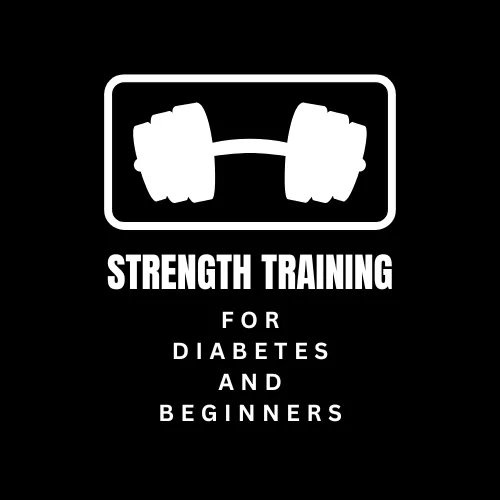
Strength Training for Diabetes and Beginners
From Diagnosis to Determination: A Beginner's Guide to Working Out with Type 2 Diabetes
Meet James (name was changed to protect his identity). At 42 years old, he was recently diagnosed with Type 2 diabetes during a routine checkup. His doctor explained that, along with managing his diet, James needed to prioritize resistance and strength training to boost his insulin sensitivity and control his blood sugar levels. The recommendation felt overwhelming. James hadn’t stepped foot in a gym since high school, and the thought of navigating unfamiliar equipment and facing judgment made him hesitant to start.
But James didn’t let his fears stop him. Instead of heading to a gym, he started at home, using simple household items: grocery bags filled with canned goods for rows (pulling the bags towards him) and bicep curls, and a sturdy chair for step-ups and tricep dips. With persistence and creativity, James not only lost 45 pounds in six months but also achieved remission from his Type 2 diabetes. Today, he feels stronger, healthier, and more confident, and his workouts have become a way to connect with his kids, who love joining him for exercises. A quote that James shares with everyone is that... "I know the diabetes can come back. Just like trying to change the shape of a rock, it takes consistent effort every day rather than trying to do everything all at once. I urge everyone to just try doing 1 more squat or standing up and sitting down from a chair 1 more time each day. Then try 2 next week. Until you can get up to 10 or even 20 or 30. Heck, even 50 is amazing. Just keep moving! Your body will take you!"
Inspired by James' journey? Let’s break down how you can start your fitness journey, improve your health, and enjoy the process—all without feeling intimidated.
---
How Exercise Helps with Type 2 Diabetes
When you have Type 2 diabetes, your body struggles to effectively use insulin, a hormone essential for managing blood sugar levels. Exercise plays a vital role in reversing this. Here’s how:
1. Increased Lean Muscle Mass: Strength training builds muscle, which boosts insulin sensitivity. Muscles act like sponges, pulling glucose (sugars) from your bloodstream and lowering blood sugar levels.
2. Improved Blood Flow: Exercise enhances circulation, reducing the risk of complications like stroke, heart attack, and amputations by promoting healthy blood flow to the entire body. Plus, it makes you look younger and helps the skin feel amazing!
3. Reduced Risk of Osteoporosis and Sarcopenia: Resistance exercises strengthen bones and prevent age-related muscle loss, keeping you strong and active.
4. Heart Health: Exercise lowers blood pressure and cholesterol levels, protecting your heart from any heart attacks or other issues.
The benefits of exercise aren’t just physical. Many people report reduced stress, better sleep, and an improved outlook on life.
---
Essential Workout Equipment for Beginners
Starting your fitness journey doesn’t require a full gym membership. Here are some affordable, space-saving tools to help you begin:
1. Resistance Bands: These versatile bands are perfect for strength training, offering varying levels of resistance to match your fitness level. Most people have weak hips that leads to knee, hip, back, and ankle problems. Try using a resistance band around your knees and walk side ways. That will strengthen your hip muscles and make it easier to walk!
Here is a resistance band you can check out on Amazon: https://amzn.to/3CymsfC
For transparency purposes, as an Amazon Associate I earn from qualifying purchases and it helps support the growth of this blog and my mission to help people with Type 2 Diabetes and Prediabetes put their disease into remission and get off as many medications as possible. I only recommend products I used or trust to improve my health and wellness.
2. Jump Rope: An excellent cardio tool, jump ropes improve heart health, coordination, and endurance. Start slow with short bursts of jumping to avoid overexertion. There was a trend of someone doing 100 jump ropes a day and the results she had was amazing! She went from 320 lbs to 280 lbs within 4 months just by being consistent with jump roping. She mentioned even if she was sore, she would space out her jumps so it could be done.
If you don't already have a jump rope, you can check out this one from Amazon: https://amzn.to/4eyEdca
3. Adjustable Dumbbells: These compact weights can be tailored to your strength level. They’re ideal for bicep curls, shoulder presses, and weighted squats. If you don't have grocery bags or hate how much they flop around when you try to do exercises with them, then it is worth the investment for your health! And when an exercise equipment is in plain sight, it makes it a lot easier to get extra reps in!
Here is a set you can get from Amazon! https://amzn.to/3UVH0VU
---
Recommended Workout Equipment
As you progress, consider adding these to enhance your routine:
1. Walking Pad: A foldable treadmill, perfect for walking at home, even while watching TV. Regular walking improves cardiovascular health and burns calories. A trick that James used is walking for 10-15 mins after every meal or when he drank calories. He found that walking or doing an activity for 10-15 mins activates the muscles to soak up the incoming blood sugar spikes from meals. If he knew that he was going to eat out at a carb-heavy restaurant, then he would walk for twice as long and encourage a friend to be with him!
Here is a link to a walking pad that can support up to 330 lbs! You can also put a desk over it and make it a walking station while getting work done or watching a TV show while getting steps in! https://amzn.to/4hQc0jM
2. Resistance Cable Bands: These heavy-duty bands offer a wider range of motion and mimic cable machines, allowing for more dynamic strength exercises. This is perfect to strengthen your back muscles, shoulders, and even address nagging neck pain!
Here are some resistance cable bands you can get from Amazon: https://amzn.to/40Tp0z0
3. Peddler: A compact cycling device you can use while seated. It’s great for low-impact cardio and leg strengthening. You can also bring it to your office so you can get some movement in to lower the blood sugars after eating lunch!
Here is a link to a foldable peddler you can get from Amazon. Be warned that since it is easier to transport, it also means it is easier to topple, so be safe when using it and it will take practice in getting used to. https://amzn.to/4fwPYkn
---
Optional Workout Equipment for Advanced Training
1. Cable Machine: If you have the space and budget, a cable machine provides a gym-like experience at home, offering endless exercise possibilities for upper and lower body strength. You can also go to the gym instead when you feel confident enough to use those machines and save money doing so. It is also a great machine to build your core strength!
Here is a link for a simple cable machine you can get from Amazon: https://amzn.to/40Y55Pk
---
Starting Simple: Workouts You Can Do at Home
James’ story is a great example of starting small. Here are some beginner-friendly exercises you can try:
Bodyweight Exercises
- Chair Squats: Sit and stand from a sturdy chair to strengthen your legs.
- Wall Push-Ups: A gentler version of push-ups, perfect for building upper body strength.
- Step-Ups: Use a low step or sturdy platform to work your legs and improve balance.
Weighted Exercises
- Grocery Bag Rows: Fill a bag with cans and use it for bent-over rows, targeting your back and arms.
- Weighted Squats: Hold the grocery bag close to your chest while performing squats.
- Bicep Curls: Use canned goods or small weights to strengthen your arms.
BONUS
If you would like a video on how to perform some of these exercises with good form to prevent an injury, check out this video here:
And if you want to start a 4 week home workout program, then you can sign up here: https://go.dptpreneur.com/widget/form/xYDG5a79E4aOTRWUGhGq
---
Building a Routine
Consistency is key. Start with:
- Frequency: Aim for 3-5 days per week, combining strength training and light cardio.
- Duration: Begin with 15-20 minutes per session and gradually increase.
- Intensity: Focus on proper form rather than heavy weights. Progress as you feel stronger.
---
Overcoming Common Challenges
1. Fear of Judgment: Remember, everyone starts somewhere. Consider online workout classes or apps to build confidence at home.
2. Lack of Equipment: Household items like water bottles or books make great substitutes for weights.
3. Motivation: Set small, achievable goals and celebrate milestones, like lowering your blood sugar levels or completing a set number of workouts.
---
James’ Success Story
After six months of consistent effort, James put his Type 2 diabetes into remission. His A1C levels returned to normal, and he no longer needed medication. He shed 45 pounds, gained lean muscle, and found joy in movement. Today, he uses his workouts as a way to bond with his kids, playing soccer in the backyard and teaching them the importance of staying active.
---
Takeaway
If you’ve been diagnosed with Type 2 diabetes, remember that starting a workout routine doesn’t have to be intimidating or expensive. Focus on small, consistent steps, and use what you have at home to build strength and confidence. With time and dedication, you’ll not only improve your health but also discover the joy of movement.
Just like James, you can turn a diagnosis into an opportunity to reclaim your health and live life to the fullest. Start today—your future self will thank you! Please share this blog with a friend in need.
Review the disclaimers here: https://www.diabetesmanagementgroup.org/legalpage
Call or Text:
(307) 288-3440
Email:
pluo@diabetesmanagementgroup.org
Website:
www.diabetesmanagementgroup.org






